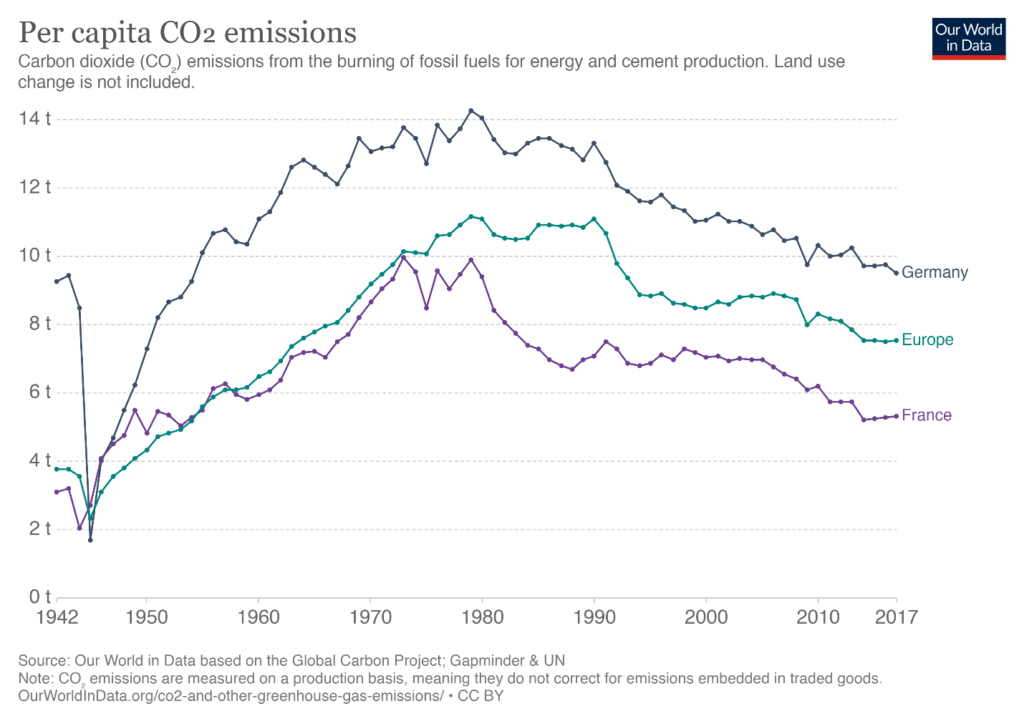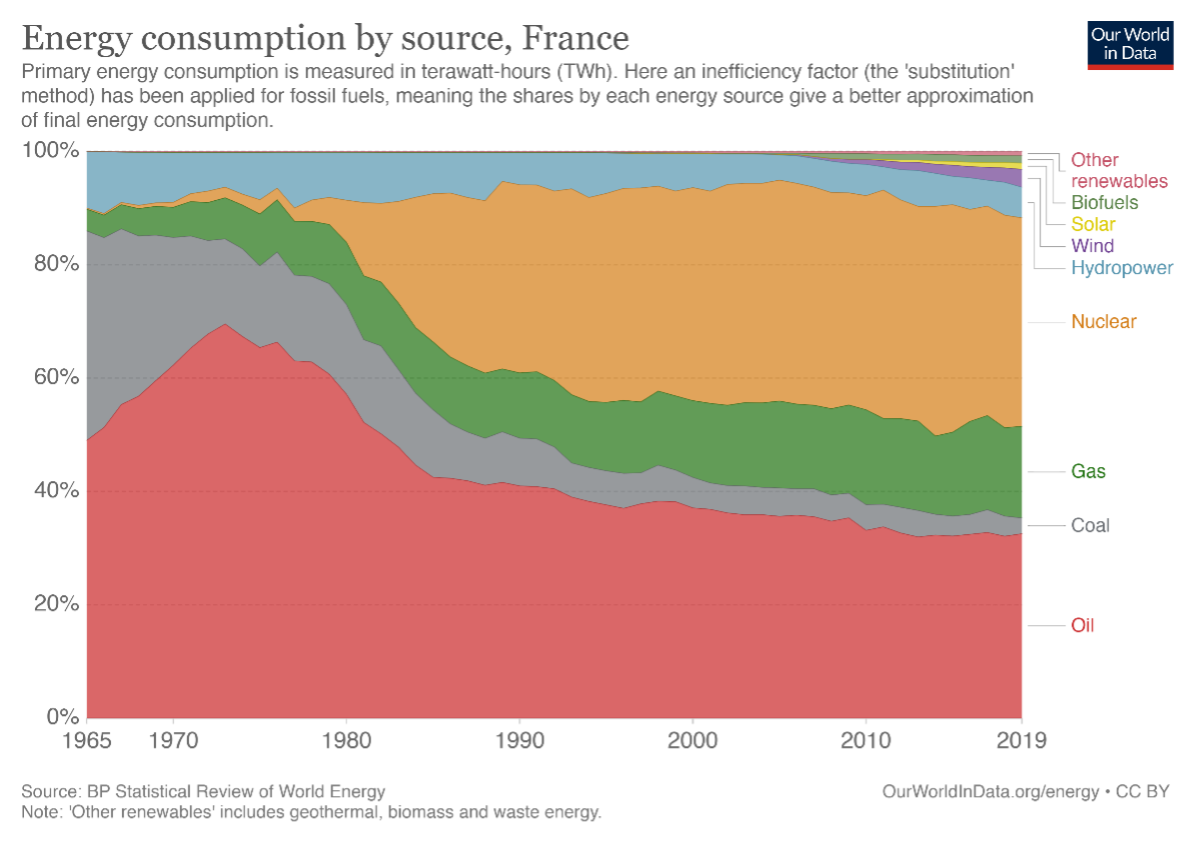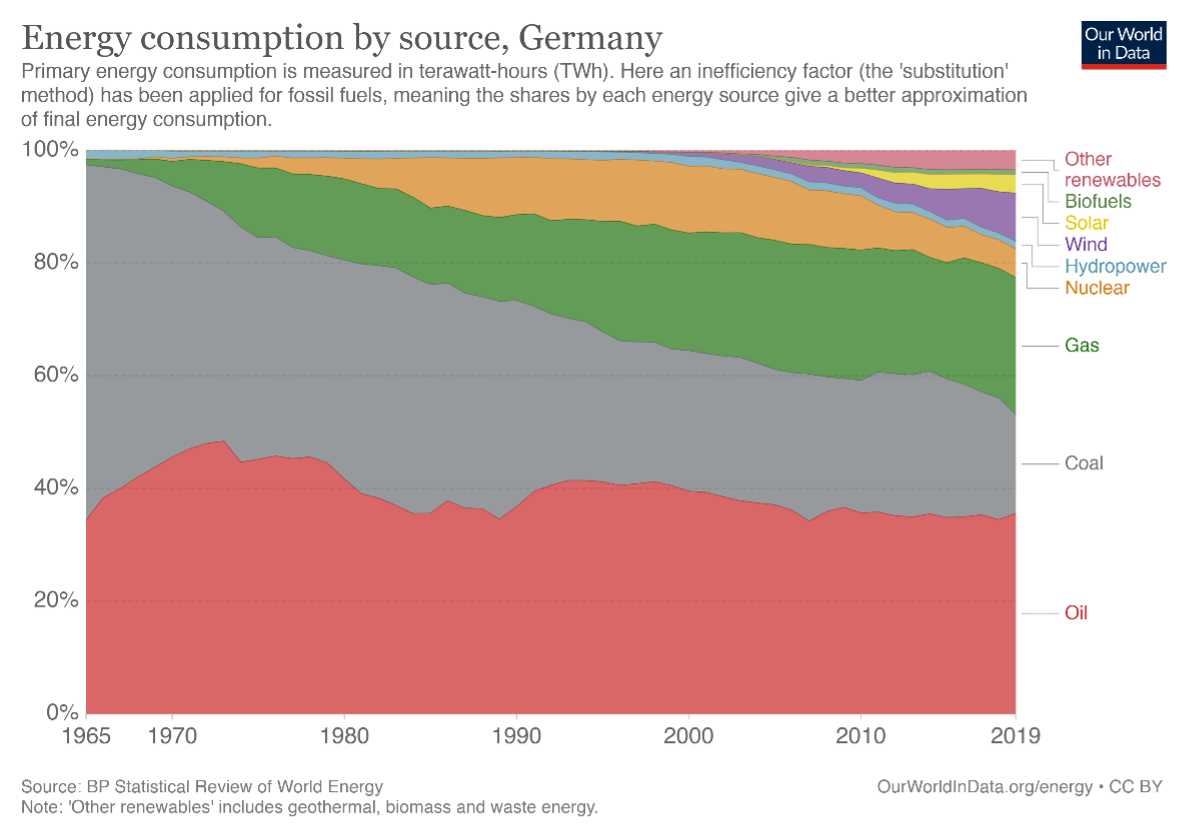
The nuclear component of Europe’s energy diet
Accelerated de-nuclearization of energy production in Europe as we transition to renewables will lead to a failure of the ‘Fit for 55’ program.
16 August, 2021
It’s better than it sounds!
The alliteration has invited incredible ridicule but has also managed to make an impression in all our minds. When mentioned outside the context of sexual promiscuity amongst senior citizens, ‘Fit for 55’ is the more palatable name to refer to the overarching goals of the European Green Deal. Frans Timmermans and his team have come up with ambitious climate targets that Member States such as Germany have described as “nothing less than a new industrial revolution in the European Union”. The proposals will now be debated between Member States and the EU for a long time as the effect that the program will have on national policies and the lives of ordinary citizens can hardly be overstated.
The primary goal of the ‘Fit for 55’ program is to reduce Green House Gas (GHG) emissions by at least 55% by 2030 (compared to 1990 levels). Achieving these targets will ensure Europe becomes the first climate-neutral continent by 2050. The Commission has come up with comprehensive proposals that target different sectors in a bid to reduce the GHG emissions produced by each of them. They range from carbon pricing mechanisms, changes in energy taxation policies, and killing the combustion engine much to the disappointment of dinosaurs such as Jeremy Clarkson. Nonetheless, this article will focus exclusively on the contribution of the energy production sector to GHG emissions and what we can do to ameliorate the status quo.

Figure 1 shows that the Energy sector contributes to nearly three quarters of all global GHG emissions. Hence the focus of the ‘Fit for 55’ campaign has rightly involved paying increased attention towards adopting renewable energy policies.

Source: Our World in Data.
Figure 2: Per Capita CO2 emissions across countries.
An Oil Crisis that changed everything
The 1970s were a big wake up call to the world to address the energy crisis. Sadly, this event was not correlated to the Club of Rome’s publication of the ‘Limits to Growth’ in 1972, but rather due to geopolitical reasons. As the West threw its might around Israel in the Yom Kippur War in 1973, and then in the wake of the Iranian Revolution, the oil producing nations of the Middle East drove up oil prices by dramatically cutting down on their supply.

Figure 3: Horses on the Autobahn – Iconic photograph from 1973 of two horses pulling a VW van in Germany at the peak of the energy crisis.
This decade reinforced to the West the necessity of having energy independence. Whilst many countries decided to go pursue their own paths towards it, the continent of Europe had initially pivoted towards adopting nuclear technology for energy independence. But a series of student protests in Germany and across many other parts of Europe that gathered steam in the 1970s torpedoed the nations plans to focus on developing its nuclear capabilities. German sociologist Dieter Rucht opined that adopting renewable energy wasn’t the end goal of these protest movements, but to merely oppose the adoption of nuclear energy, was. As political parties such as the Christian Democratic Union (CDU) and the Social Democrats (SPD) threw their weight behind the anti-nuclear movement, Germany took a turn towards exploiting the abundance of coal in the Ruhr Valley and developed its fossil fuel-based energy supply. France on the other hand, went the other way. In Figure 2 we can clearly see the trend of CO2 emissions in Germany and France from 1940 till the present day, with the spike in the 1970s.
“No oil, no gas, no coal, no choice” was the slogan at the times that helped Prime Minister of France between 1972-74, Pierre Messmer, to instill within the French the need for drastic measures. And as the Messmer Plan was laid out to form, energy independence through nuclear energy was at the crux of it all. Over the next 15 years, France installed 56 nuclear reactors and began its path of energy self-sufficiency. Aided by sharp public relations strategies and appealing to inherent French culture, the people of France were cajoled into not just accepting but appreciating the presence of nuclear energy and the benefits they receive because of it. French engineers, unlike the Russians, have shown their competence in handling nuclear power generation and it has been nearly 40 years of peaceful and successful nuclear energy production.
Today, France is the biggest net exporter of electricity in the world, because of the excess power it generates through nuclear energy sources. Out of the 39.4 terrawatt-hours (TWh) of power exported by France in 2019, Germany had imported nearly 11.9 TWh for consumption and distribution. Therefore, with a pinch of hyperbole, it could be said that Germany’s accelerated de-nuclearization is an elaborate charade of the NIMBY (not in my back yard) syndrome, a usual suspect in discussions surrounding nuclear energy. But to close the argument on the lines of the ‘Fit for 55’ campaign, all one needs to do is to look at the GHG emissions that have been produced in Germany and France since the 1970s till today. Juxtaposing the data from emissions with the patterns for energy production makes a very strong case against the Fatherland for giving up on nuclear energy at an accelerated rate in the last decade. While it has been nearly 40 years of peaceful and successful nuclear energy production across the border in France.

Source: Our World in Data.
Figure 4: The 2 figures showcase the energy consumption patterns between France and Germany over the years. Nuclear energy production is starkly different across the 2 countries.
The shortcomings of Nuclear Energy production
Whilst the ability of nuclear energy to be a non-GHG-emitting source of power generation is evident, there is still an audible gasp from the collective common populace if nuclear energy is addressed as a ‘clean source of energy’. Rightly so, since it does come with its disadvantages. Nuclear energy receives its pushback on two fronts namely,
- Nuclear safety
- Nuclear waste
Without disregarding the disastrous consequences of a mishap in both fronts, there is merit in a deep dive into them. First of all, nuclear safety as a problem has a well-documented history, and has even entered into popular culture through a thrilling drama mini-series or as a Berlin based digital art project for an energy drink. What can one say, Berlin right? If we look at Chernobyl, the accident was caused by staff overriding automatic fail-safe mechanisms to conduct a risky experiment. And because of an inherent design fault in the control rods, there occurred an explosion. Since the event, there has been considerable progress in nuclear safety, reactor design, and believe it or not, common sense. This makes it extremely unlikely that a human error could cause such another catastrophic event. While that may be a reductionist argument, one only must look at France that has been operating its 56 nuclear power plants since the 1970s without a single incident till date. This is evidence enough to show that while the task of ensuring safe nuclear power generation maybe arduous, it is still very much possible.
Fukushima on the other hand was an act of God (or science, if you are Nietzsche). But it only takes a superficial understanding of plate tectonic theory to know that this was a disaster waiting to happen. But for those who are lazy to google it, here’s a quick lesson in geography. The tectonic plates are huge irregularly shaped slabs of slid rock present in the continental and oceanic lithosphere of the earth. Basically, earth and life as we know it exists on these tectonic plates. There are seven major and numerous minor tectonic plates on the earth and natural disasters such as earthquakes, volcanic eruptions, and tsunamis primarily occur at the regions where there is a collision between two tectonic plates. In the case of the Fukushima nuclear disaster, the larger Pacific Plate was colliding continuously with the smaller Okhotsk Plate, which lead to a subduction of the larger plate and ultimately to a massive shift, laterally and upward, by a measure of 40 meters. While 40 meters may not seem much in terms of a distance to walk, for a continent to move up or down by it isof considerable magnitude. That lead to the 8.9 Richter scale earthquake that rocked Japan in 2011 leading to the collapse of the Fukushima nuclear power plant. But this was not the first earthquake Japan has faced. Earthquakes and Japan have a history that is probably as old as time itself hence there has definitely been some questionable policy decisions when the approval to construct nuclear power plants in such a seismically active region was given
So where are Europe’s nuclear reactors? All on the same, single slab, called the Eurasian Plate. The Eurasian plate covers the entirety of east and north Asia, and Europe. It is the largest tectonic plate on earth and hence does not experience any major tectonic activity. This greatly reduces the possibility of tectonic activity recreating a Fukushima like event in Germany. Yet the accelerated nature of Germany’s de-nuclearization program has hinged considerably on an event that cannot geologically occur in its country.
Nuclear waste on the other hand is a real problem. But this has been addressed considerably by certain countries and poorly by certain others. France for example has ensured that through recycling, 96% of all spent uranium can be recovered and re-used. In the Cotentin Peninsula in northern France, exists a commune by the name La Hague that houses a nuclear waste processing plant. La Hague has safely processed over 23,000 tons of spent fuel since the 1960s, enough to run modern day France for 14 years. China, one of the biggest emitters of GHG emissions is moving in the direction of nuclear energy to meet its energy demands and has even foreshadowed the problem of nuclear waste thereby working together with France to build a nuclear waste processing plant. And for the very miniscule amount of fuel that is unrecyclable, they are stored in containers in nuclear repositories deep under the ground. Onkalo, the first IAEA repository of nuclear waste is in Finland and is expected to be a game changer in dealing with nuclear waste. France, under the expertise of a shrewd politician Christian Bataille ensured acceptance of such underground processing plants after initial resistance by changing the policy.
“In France we bury the dead, therefore the earth is sacred”. Contaminating it with nuclear waste would be cultural profanity at best and blasphemy at worst. Hence Bataille worked towards conveying the message that nuclear waste is not disposed permanently but merely stored to be accessed and dealt with in the future. It should be made accessible in the future so that as time and technology progresses, old nuclear waste could be recycled. The policy was passed in 2006 and today we have multiple centers that store nuclear waste in France, safely and securely.
Does that mean nuclear energy is the future?
Yes and no. While my background in Chemical Engineering truly makes me believe that technological breakthroughs can ensure that Small Nuclear Power Reactors and Generation IV Breeder Reactors will be commonplace in the future, we are years away from a mere proof of concept. Furthermore, none of the currently existing nuclear reactors are equipped to handle climate change and if recent events have shown the global north that flooding can happen not just in poor countries, there needs to be some reconsideration. As nuclear power plants are primarily near bodies of water that they use to cool the reactor, flooding is a real threat to their existence. Considering the rate at which the planet is currently warming, these years are exactly what we do not have. Hence there is great merit in the ‘Fit for 55’ plan and the increased investment in renewable energies. Furthermore, investments and research in the field of renewables have greatly reduced the cost of energy. Figure 5 is evidence of the same.

Figure 5: The falling costs in energy production
While renewable energy has definitely become cheaper it brings additional problems with it, namely storage. Battery capacities to ensure power is backed up when the weather conditions aren’t particularly favorable, have not seen great improvements. This has ensured that while energy production remains cheap, the storage of it is rather expensive. The same applies for wind energy. Furthermore, the demand for electric energy usage witnessed by an increase in electric mobility and smart cities has led to increased mining of the earth in search of rare earth metals that are used to make batteries for storing energy. Increased mining can exacerbate conditions of the earth in ways that we have not imagined before causing further environmental damage.
Offshore wind plants on the other hand seem to be the most plausible solution to the problem of energy storage. Having more consistency and a higher ability to produce energy in unfavorable circumstances, it has clearly proved itself to be the bench mark of renewable energy production. But the EU is still a few decades away before these wind plants achieve a ubiquity enough to meet the energy demands of all 27 states. For as long as that doesn’t happen, we need a solution. Nuclear Energy is that stop gap.
Holding on for Benthamite reasons
To conclude, the unaddressed elephant in the room in the ‘Fit for 55’ plan, is in the shape of nuclear energy. As we still play catch up with battery technology and building capable renewable energy sources, nuclear power will continue to provide zero-carbon emitting energy to Europe for a considerable period of time. France has smartly laid out its energy contributions by agreeing to work towards increasing its production of renewable energy but reducing its nuclear capacity to only 50% of current levels by 2035, compared to Germany’s nuclear program that is already on its death bed. The smartest policy recommendations would be to ensure that nuclear energy is gradually phased out but accelerated de-nuclearization of energy sources in the European continent will ensure that Fit for 55 becomes a failure.
Unless there’s an accelerated adoption of renewable energy production mechanisms that are being created at the moment. The Social Climate Fund and the renewable energy directive may not suffice to keep up with the energy demands of theincreasingly tech savvy world of tomorrow. And when the demand for electricity increases, poorer EU countries such as Poland and Hungary will refocus their energy generation capacities on coal and fossil fuel-based power plants.
The threats possessed by nuclear energy are real and advocating for its future is a different discussion. Technology will progress to make sure that nuclear energy becomes safer and experiences an increased acceptance in the world. The thing is, we may not be alive to see that world, but it is definitely our responsibility to ensure that such a world will come. For that to happen, we need to ensure an acceleration of all our renewable energy programs and increased investment in energy storage technology but do not drop the guillotine on nuclear energy yet. This toxic relationship with nuclear energy is one that we may need to die a slow death, for unlike toxic relationships in general, Fit for 55 will fall short of its goals, if we let go of this one too soon.
